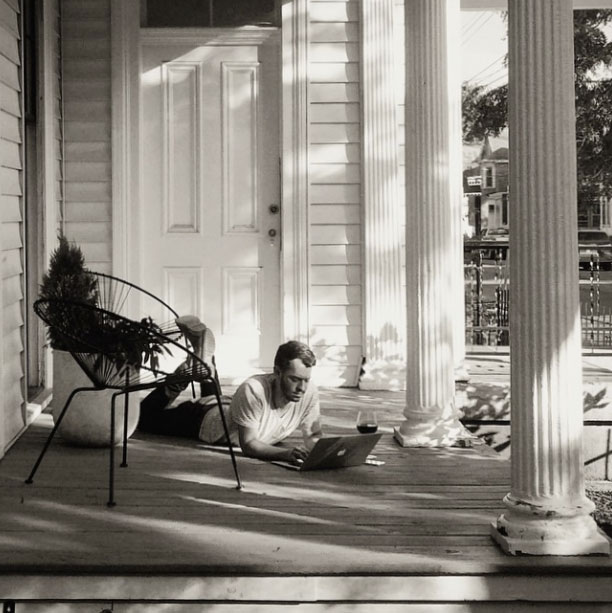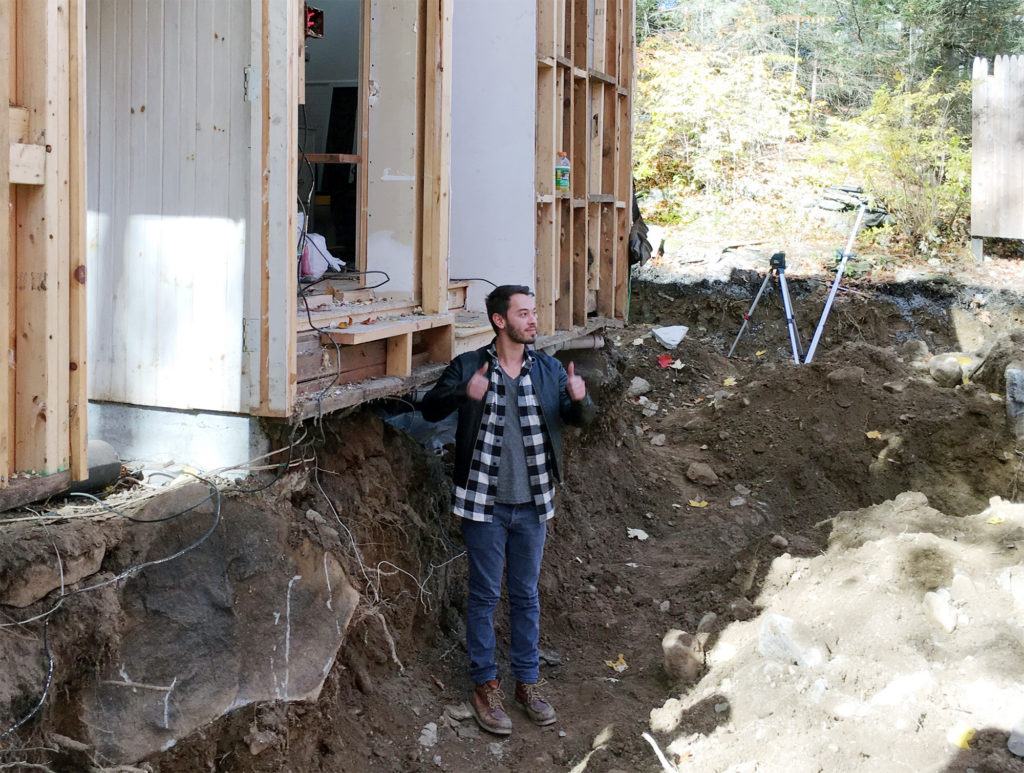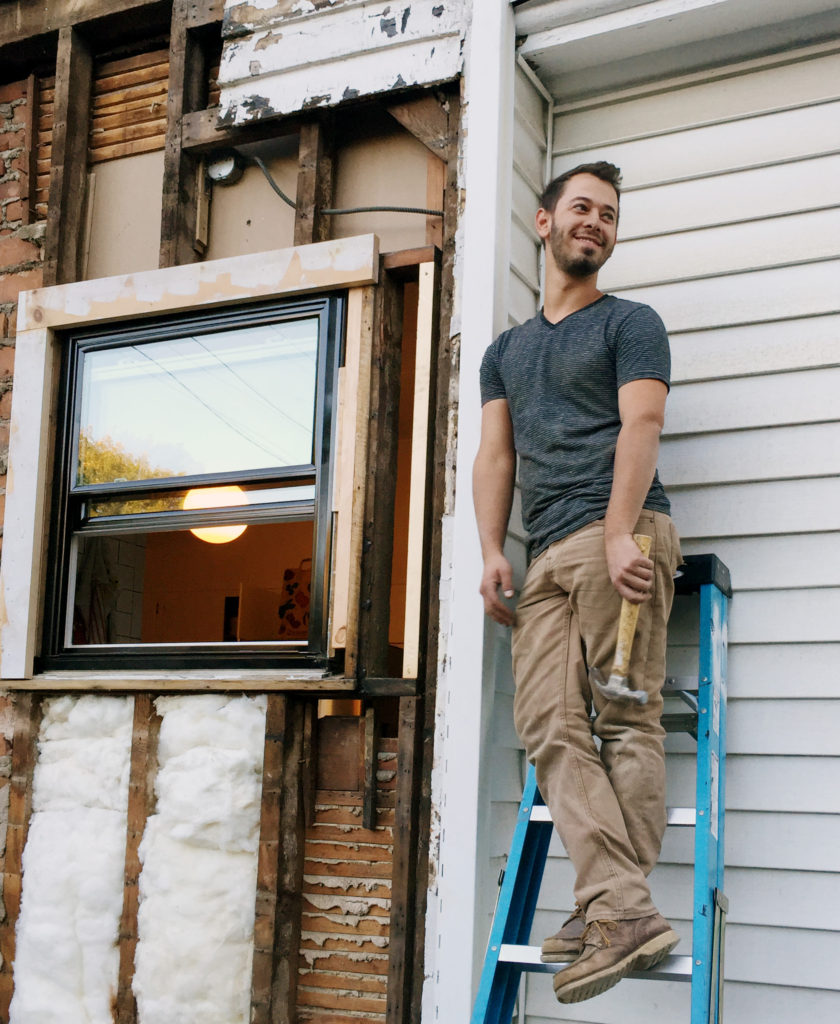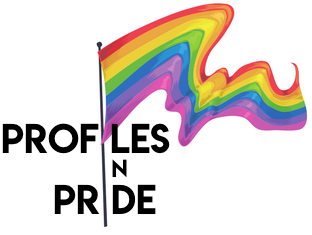When he was 20 years old, Daniel Kanter decided to start a blog. He was leaving his college dorm and moving into his first apartment in Manhattan, and he thought it would be fun to document making it into a home. Most home improvement and DIY blogs he found were of the Christian mommy blog variety, which, as a gay man, he felt weren’t quite written for him. So Kanter started the blog Manhattan Nest in 2010, in part to bring a different voice into the space.
He had no expectation for the blog, but readership quickly grew, and home renovation became his career and passion. In 2013, Kanter moved to Kingston, New York, and bought an 1865 fixer-upper. His blog documents the process of restoring it (which he’s still working on), among other projects. In addition to running his popular blog and working on his own projects, Kanter also does freelance renovation projects for clients, many of which he shares on his blog.
Kanter is also gay, which some people make a big deal out of, but he thinks it’s the least remarkable thing about him. He doesn’t fit the typical gay stereotypes, he says: he’s not the macho contractor you see on HGTV, but he’s also not the flamboyant designer you see on other shows. He just considers himself a home renovator who happens to be gay. Kanter, now 29, occasionally gives readers a peek into his personal life — he shared when he got engaged to a man and when the engagement ended — but in general, he doesn’t want being gay to be his only identity.
Read on to learn about Kanter’s experience of coming out as gay, starting his successful blog and business, breaking gay stereotypes, and more.
Profiles in Pride: When did you realize you were gay, and what did coming out look like for you?
Daniel Kanter: Well, it wasn’t what my mother dreamed it would be. I’d imagine when you have a kid you think is probably gay, you expect that information to be presented in a particular way, and I missed that memo.
When I was little — and I think this is a pretty common experience — classmates and other people asked if I was gay, or said I was gay before I really knew what it meant. I guess when I was 14 or so, I started to understand that for myself. I feel like things like my voice and my mannerisms are sort of a blessing and a curse, because I don’t have to come out over and over again in the way that some gay people do — people just assume! So I technically didn’t come out to my parents until I was 21 when I was bringing home my first serious boyfriend. I was coming home for something anyway, and I texted my parents something like, “Hey, can I bring my boyfriend?” And apparently that was a shock!
But my dad was super sweet and was immediately like, “How did you meet? How long has it been?” It was so nice. I felt pretty confident that my family would be accepting, and I didn’t feel like I really had to declare myself that way until it was relevant. That was true on the blog too; I didn’t identify one way or the other until I introduced who I was with.

PIP: When you and your fiance broke up, you wrote about it on the blog and shared more of your personal life than usual. How do you decide how much of your sexuality and personal life to reveal?
DK: I’m still figuring that out, I think. We were together about four years, and after we broke up, and I wrote about that, I got a little too much feedback. I had preemptively closed comments on that post, but people find a way to tell you what they think. Because it was really personal, it was kind of all too much, so I scaled back significantly on how I talk about my love life. But it felt like it was a big part of my life and it affected my living space, which is essentially what the blog was about, because somebody moved in and brought their own stuff and own sense of style. So it felt very relevant to what I was writing about.
There are certain personal lines I felt like I didn’t want or need to cross. I never talked about how we met, for instance. To me, it was important to be able to show our relationship as just something in the background of everything you’re reading, but it’s not the star of the show; it’s not the most important thing. To me, that can feel exploitative.
When I started the site, I was reading all these DIY blogs where the undertone was very Christian, conservative, and heteronormative. I knew that what I was doing was taking that format and making it young and gay and male and liberal. So it felt natural to present our relationship in a way that was pretty unremarkable.
A couple times I’ve gotten up on my soapbox. Before the 2014 election when gay marriage was a big issue, the blog allowed me to talk about those things in a way that just felt more personal than overly political. Obviously some people didn’t take it that way, but for the most part, all feedback I’ve gotten—even when I talk about things like that—is fine and generally really positive. I hope it’s built some acceptance among readers that maybe aren’t exposed to those things, because I know I share readership with a lot of those types of blogs I mentioned.
I like to think being gay the least interesting thing about me. I think it’s more interesting to other people. If it helps them understand something they didn’t, if it gains exposure and acceptance, that’s great. It’s not my main goal, but it’s great.

PIP: Absolutely. So you work very closely with men named Edwin and Edgar, who are both immigrants. Home improvement TV shows tend to be very whitewashed and don’t show the people working behind the scenes, but you feature them often. Is it a conscious decision you’ve made to give them that visibility, especially given the political climate?
DK: Fundamentally, I think it is important. When I started working with them, Edwin lived next door to me and I saw a sign on his truck that he did painting and drywall. We ended up doing a bunch of other projects together. Edwin gets a kick out of seeing himself on the blog and on Instagram and stuff.
Unfortunately, I guess it has become more of a conscious choice to make sure they’re getting highlighted in some way. I don’t know what the hell is wrong with people, but to me it drives home that this is a real fucking person, and he’s at risk of deportation because of the Trump administration. Plain and simple. And it’s not just about him and his family, if you have a problem with them. It’s also about me and my small business, and the people I rely on for everything. If their situation goes south, so does mine and so do a lot of people. It’s a horrifying possibility for everyone involved.
I also want to be very careful, because it can easily feel exploitative. I try to be very cautious about how I talk about them. It’s tricky territory and I get it. I never want it to come across like, “Here are these brown people I let work for me!” We wouldn’t have five years of working together if that relationship wasn’t built on respect and a legitimate bond. Those guys are my brothers and I try to help them where I can, regardless of whether I’m involved in the job. Edgar is much less fluent that Edwin, and neither of them are computer savvy, so it’s hard for them to manage the business side.
Before we started working together, most of their work was just painting and drywall, and now they’ve built an entire house and gotten to take on big renovation projects that they either wouldn’t have had the skills necessary to do it on their own, or been written off by a potential client regardless just because of a language barrier. So I try to open up opportunities for them; it’s super important to me.

PIP: That’s wonderful. We saw you did design work for Ana Gasteyer — how did that happen? And how do you get most of your clients?
DK: I’m trying to phase interior design work out a little. Ideally I wouldn’t really do client work at all, just because I like to be in total control of everything, and I don’t get to do that when there’s a client involved. With renovation, I think the work is more stimulating, so I can be more OK with things not going exactly how I want. With decorating, either let me choose the drapes or don’t, but I don’t want to go back and forth 11 times about it!
Most of my work has come through the blog; either a reader emails me or somebody refers somebody to go look at it and then they email me. I’ve also done a fair amount of work for friends and people close to me, who are still paying clients. I learned to avoid talking about them as friends because that’s an easy way for people to think you work for free on favors, and I don’t!
Maybe it’s just a New York thing, but I also got really weirdly lucky. My first client — who didn’t pay me, but I was so young and excited — was this guy Daniel Vosovic from Project Runway. I ran into him on the street in Manhattan and said hi because I recognized him from the show. He was very kind and asked what I did. I said I had a blog, and he said, “I know that blog!”
I emailed him a few days later because I hadn’t been aware of any of the work he’d done since the show, so I caught myself up and I reached out and said, “You’re doing great stuff, and it was really nice to meet you.” Then he said, “Would you actually want to come over and help me with my apartment?” He was living in a live/work studio space and so I did, and I ended up doing the whole thing!
I should mention in retrospect that Daniel was inspiring to me without knowing it, because he’s one of the first gay people I can remember seeing on TV who wasn’t totally defined by his gayness. That was, what, 2005? I actually think it took most of the season for it to ever be addressed, although I could be wrong about that.
I think watching him really signaled to me that I could be gay without putting it front and center, and that my work could stand on its own merit and not because I was some novelty for straight people. Actually, ending up working with him and being able to call him a friend is kind of crazy, now that I think about it, because his impact on me years before we met was kind of profound.
The Ana Gasteyer job was referred to me through the blog Design*Sponge. They did a little bit of consulting work for her, though that’s not really what they do. Ana was looking for someone to really do her house, so they recommended me. I was like, uh, sure! So I did! And it was fun. She’s so great. Then just a month or so ago I saw it got included in Hygge & West’s new book—we used a couple of their wallpapers in her house. Someone took professional photos of my work and included it in a book! It’s been five years and it still looks pretty much like the day I left. That was very cool!

PIP: We saw you were also appointed by the mayor to a position in Kingston; tell us about it!
DK: Part of what I love about where I live is there’s a lot of opportunity to get involved. I actually ran for city council three years ago, which was a bad idea! But I stumbled through it, and then this came along. One of the current city council members said they were looking people to get involved, so I filled out a standard application to join any kind of board or commission. Then one morning I was lying in bed and got a call from the mayor!
I got appointed to be on the founding board of directors for the Kingston City Land Bank, which will basically be in charge of dealing with city-owned properties that are vacant. Getting them back onto the tax rolls and with people living in them. All I really know is there’s some good funding in place and they put together this board of eight people, and I think the first order of business is figuring out what the hell we’re doing and how we’ll do it. That could look like an affordable housing situation or a kind of program where you’d have to perform certain things in a set timeframe in exchange for getting a cheap house from the city.
PIP: Before we go, is there anything else you want to share?
DK: I think what you mentioned earlier about TV people and the straight white guy contractor on TV, professionally that’s a big challenge for me, because I definitely don’t fit that mold. But I also don’t really fit the whole “I’m gay and I just like to make stuff pretty and Fab Five it!” thing.
I hope part of what my blog can do insofar as identity is show by example that there’s no one way to be acceptably gay in the world to straight people as an audience.
You can just be whatever it is that you want to be, and some people will like that and other people won’t. I get frustrated with the limited categories of people working in this field, in terms of how we see them in the media. I’ll never get cast by some HGTV executive, and that’s OK. But I have been able to get major corporations to see what I have to offer and be willing to pay me for it, and get great clients, and have a really lovely readership of positive, kind people on my blog who don’t need me to be a different person to get something out of what I’m doing.
As a gay person, I think we’ve made really big strides in terms of visibility and acceptance, and I think now part of the major work is breaking that open a little bit and being able to show that you don’t have to be or fit into one of the archetypes that we’re told is acceptable.
Check out Daniel’s blog, Manhattan Nest, and find him on Instagram @danielkanter.
Big thanks to our proofreader Katherine Kinard for assisting us with this interview!

